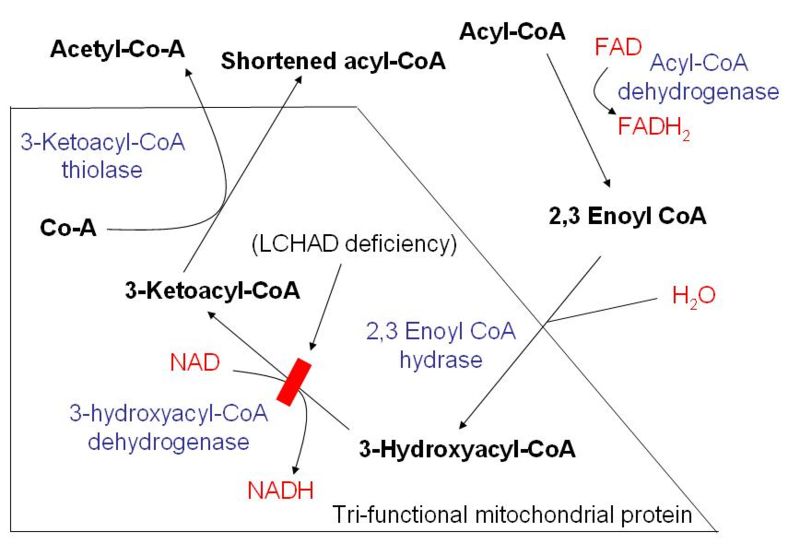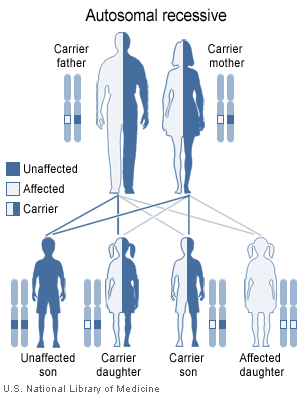Acute fatty liver of pregnancy
| Acute fatty liver of pregnancy | |
| ICD-10 | O26.6 |
|---|---|
| ICD-9 | 646.7 |
| OMIM | 609016 600890 |
| DiseasesDB | 32879 |
Editor-In-Chief: C. Michael Gibson, M.S., M.D. [1] Assosciate Editor(s)-In-Chief: Prashanth Saddala M.B.B.S
Overview
Acute fatty liver of pregnancy is a rare life-threatening complication of pregnancy that occurs in the third trimester or the immediate period after delivery.[1] It is thought to be caused by a disordered metabolism of fatty acids by mitochondria in the fetus, caused by deficiency in the LCHAD (long-chain 3-hydroxyacyl-coenzyme A dehydrogenase) enzyme.[2] The condition was previously thought to be universally fatal [3], but aggressive treatment by stabilizing the mother with intravenous fluids and blood products in anticipation of early delivery, has improved prognosis.[4]
Historical Perspective
The disease was first described in 1940 by H. L. Sheehan as an "acute yellow atrophy" of the liver, and thought to be related to delayed chloroform poisoning.[1][5]
Epidemiology and Demographics
Acute fatty liver of pregnancy is a rare condition and occurs in approximately one in 7,000 to one in 15,000 pregnancies.[3] [6] The mortality from acute fatty liver of pregnancy has reduced significantly to 18%, and is now related primarily to complications, particularly DIC and infections.[1][3] After delivery, most mothers do well, as the stimulus for fatty acid overload is removed. The disease can recur in future pregnancies, with a calculated genetic chance of 25%; the actual rate is lower, however.[7] Mortality of the fetus has also diminished significantly, but still remains 23%,[8] and may be related to the need for premature delivery.[1]
Pathophysiology
The understanding of the causes of acute fatty liver of pregnancy has been ameliorated by advances in mitochondrial biochemistry. Deficiency of LCHAD (3-hydroxyacyl-CoA dehydrogenase) leads to an accumulation of medium and long chain fatty acids. When this occurs in the fetus, the unmetabolized fatty acids will re-enter the maternal circulation through the placenta, and overwhelm the beta-oxidation enzymes of the mother.[7] The gene responsible for LCHAD has been isolated, and the most common mutation found in acute fatty liver of pregnancy is the E474Q missense mutation.[9] The disease is autosomal recessive in inheritance and mothers are often found to be heterozygous for the affected mutation.[10]


Histopathology
On the regular trichrome stain, the liver cell cytoplasm shows a foamy appearance due to the prominence of fat. Necrosis is rarely seen. On electron microscopy, microvesicular steatosis, megamitochondria and paracrystalline inclusions are seen.[11][6]
Differential Diagnosis
Often testing will be done to exclude more common conditions that present in a similar fashion, including viral hepatitis,[12] pre-eclampsia,[13] HELLP syndrome,[4] intrahepatic cholestasis of pregnancy,[1] and autoimmune hepatitis.[3]
Natural history, Complications and Prognosis
In more patients with more severe disease, pre-eclampsia may occur, which involves elevation of blood pressure and accumulation of fluid (termed edema).[13] This may progress to involvement of additional systems, including acute renal failure,[14] hepatic encephalopathy,[15] and pancreatitis.[16] There have also been reports of diabetes insipidus complicating this condition.[17]
Diagnosis
The diagnosis of acute fatty liver of pregnancy is usually made on clinical grounds by the treating physician, but differentiation from other conditions affecting the liver may be difficult.[1] The diagnosis of acute fatty liver of pregnancy is suggested by jaundice with a lesser elevation of liver enzymes, elevated white blood cell count, disseminated intravascular coagulation, and a clinically more unwell patient.[4]
History and Symptoms
Acute fatty liver of pregnancy (or hepatic lipidosis of pregnancy) usually manifests in the third trimester of pregnancy, but may occur any time in the second half of pregnancy, or in the puerperium, the period immediately after delivery.[1] On average, the disease presents during the 35th or 36th week of pregnancy.[13]. The usual symptoms in the mother are non-specific including nausea, vomiting, anorexia (or lack of desire to eat) and abdominal pain [13]; however, jaundice and fever may occur in as many as 70% of patients.[1][18]
Laboratory tests
Many laboratory abnormalities are seen in acute fatty liver of pregnancy. Liver enzymes are elevated, with the AST and ALT enzymes ranging from minimal elevation to 1000 IU/L, but usually staying in the 300-500 range.[1] Bilirubin is almost universally elevated. Alkaline phosphatase is often elevated in pregnancy due to production from the placenta, but may be additionally elevated.[4] Other abnormalities may include an elevated white blood cell count, hypoglycemia, elevated coagulation parameters, including the international normalized ratio, and decreased fibrinogen.[1] [4] [13] Frank disseminated intravascular coagulation, or DIC, may occur in as many as 70% of patients.[1]
Ultrasound
Abdominal ultrasound may show fat deposition in the liver, but, as the hallmark of this condition is microvesicular steatosis (see pathology below), this may not be seen on ultrasound.[19] Rarely, the condition can be complicated by rupture or necrosis of the liver, which may be identified by ultrasound.
Liver Biopsy
A liver biopsy can provide a definitive diagnosis, [20] but is not always done, due to the increased chance of bleeding in acute fatty liver of pregnancy.[21] If a liver biopsy is needed for diagnosis of the condition, the mother should be appropriately stabilized and treated to reduce bleeding related complications. The diagnosis can be made by a frozen-section (as opposed to a specimen in formalin) that is stained with the Oil red O stain, that shows microvesicular steatosis (or small collections of fat within the liver cells). The microvesicular steatosis usually spares zone one of the liver, which is the area closest to the hepatic artery. On the regular trichrome stain, the liver cell cytoplasm shows a foamy appearance due to the prominence of fat. Necrosis is rarely seen. The diagnosis can be enhanced by electron microscopy which can be used to confirm the presence of microvesicular steatosis, and specifically the presence of megamitochondria and paracrystalline inclusions.[22][6] Liver diseases with similar appearances include Reye's syndrome, drug-induced hepatitis from agents with mitochondrial toxicity, including nucleoside reverse transcriptase inhibitors used to treat HIV,[23] and a rare condition known as Jamaican vomiting syndrome.[24]
Treatment
Acute fatty liver of pregnancy is best treated in a centre with expertise in hepatology, high-risk obstetrics, maternal-fetal medicine and neonatology. The physicians who treat this condition will often consult with experts in liver transplantation in severe cases. Admission to the intensive care unit is recommended.[1]
Initial treatment involves supportive management with intravenous fluids, intravenous glucose and blood products, including fresh frozen plasma and cryoprecipitate to correct DIC. The fetus should be monitored with cardiotocography. After the mother is stabilized, arrangements are usually made for delivery. This may occur vaginally, but, in cases of severe bleeding or compromise of the mother's status, a caesarian section may be needed.[1]
The complications of acute fatty liver of pregnancy may require treatment after delivery, especially if pancreatitis occurs.[16] Liver transplantation is rarely required for treatment of the condition, but may be needed for mothers with severe DIC, those with rupture of the liver, or those with severe encephalopathy.[25]
References
- ↑ 1.00 1.01 1.02 1.03 1.04 1.05 1.06 1.07 1.08 1.09 1.10 1.11 1.12 Ko HH, Yoshida EM. Acute fatty liver of pregnancy. Can J Gastroenterol. 2006 Jan;20(1):25-30. PMID 16432556
- ↑ Bellig LL. Maternal acute fatty liver of pregnancy and the associated risk for long-chain 3-hydroxyacyl-coenzyme a dehydrogenase (LCHAD) deficiency in infants. Adv Neonatal Care. 2004 Feb;4(1):26-32. PMID 14988877.
- ↑ 3.0 3.1 3.2 3.3 Mjahed K, Charra B, Hamoudi D, Noun M, Barrou L. Acute fatty liver of pregnancy. Arch Gynecol Obstet. 2006 Jul 26 (electronic) PMID 16868757
- ↑ 4.0 4.1 4.2 4.3 4.4 Riely CA. Liver disease in the pregnant patient. American College of Gastroenterology guidelines. Am J Gastroenterol 1999 Jul;94(7):1728-32. PMID 10406228
- ↑ Sheehan HL. The pathology of acute yellow atrophy and delayed chloroform poisoning. J Obstet Gynaecol Br. Emp. 1940;47:49-62.
- ↑ 6.0 6.1 6.2 Reyes H, Sandoval L, Wainstein A, Ribalta J, Donoso S, Smok G, Rosenberg H, Meneses M. Acute fatty liver of pregnancy: a clinical study of 12 episodes in 11 patients. Gut 1994 Jan;35(1):101-6. PMID 8307428>
- ↑ 7.0 7.1 Tein I. Metabolic disease in the fetus predisposes to maternal hepatic complications of pregnancy. Pediatr Res. 2000 Jan;47(1):6-8. PMID 10625076
- ↑ Fesenmeier MF, Coppage KH, Lambers DS, Barton JR, Sibai BM. Acute fatty liver of pregnancy in 3 tertiary care centers. Am J Obstet Gynecol. 2005 May;192(5):1416-9. PMID 15902124.
- ↑ IJlst L, Oostheim W, Ruiter JP, Wanders RJ. Molecular basis of long-chain 3-hydroxyacyl-CoA dehydrogenase deficiency: identification of two new mutations. J Inherit Metab Dis. 1997 Jul;20(3):420-2. PMID 9266371
- ↑ Wanders RJ, Vreken P, den Boer ME, Wijburg FA, van Gennip AH, IJlst L. Disorders of mitochondrial fatty acyl-CoA beta-oxidation. J Inherit Metab Dis. 1999 Jun;22(4):442-87. PMID 10407780
- ↑ Bacq Y. Acute fatty liver of pregnancy. Semin Perinatol. 1998 Apr;22(2):134-40. PMID 9638907
- ↑ Pang WW, Lei CH, Chang DP, Yang TF, Chung YT, Huang MH. Acute jaundice in pregnancy: acute fatty liver or acute viral hepatitis? Acta Anaesthesiol Sin. 1999 Sep;37(3):167-70. PMID 10609353.
- ↑ 13.0 13.1 13.2 13.3 13.4 Riely CA. Acute fatty liver of pregnancy. Semin Liver Dis. 1987 Feb;7(1):47-54. PMID 3296215
- ↑ Koroshi A, Babameto A. Acute renal failure during acute fatty liver of pregnancy. Nephrol Dial Transplant. 2002 Jun;17(6):1110-2. PMID 12032205
- ↑ Aggarwal R. Hepatic encephalopathy in pregnancy. Indian J Gastroenterol. 2003 Dec;22 Suppl 2:S78-80. PMID 15025263
- ↑ 16.0 16.1 Moldenhauer JS, O'brien JM, Barton JR, Sibai B. Acute fatty liver of pregnancy associated with pancreatitis: a life-threatening complication. Am J Obstet Gynecol. 2004 Feb;190(2):502-5. PMID 14981397
- ↑ Kennedy S, Hall PM, Seymour AE, Hague WM. Transient diabetes insipidus and acute fatty liver of pregnancy. Br J Obstet Gynaecol 1994 May;101(5):387-91. PMID 8018608.
- ↑ Riely CA, Latham PS, Romero R, Duffy TP. Acute fatty liver of pregnancy. A reassessment based on observations in nine patients. Ann Intern Med. 1987 May;106(5):703-6. PMID 3565968.
- ↑ Castro MA, Ouzounian JG, Colletti PM, Shaw KJ, Stein SM, Goodwin TM. Radiologic studies in acute fatty liver of pregnancy. A review of the literature and 19 new cases. J Reprod Med. 1996 Nov;41(11):839-43. PMID 8951135
- ↑ Brunt EM. Liver biopsy interpretation for the gastroenterologist. Curr Gastroenterol Rep. 2000 Feb;2(1):27-32. PMID 10981000
- ↑ Castro MA, Goodwin TM, Shaw KJ, Ouzounian JG, McGehee WG. Disseminated intravascular coagulation and antithrombin III depression in acute fatty liver of pregnancy. Am J Obstet Gynecol. 1996 Jan;174(1 Pt 1):211-6. PMID 8572009
- ↑ Bacq Y. Acute fatty liver of pregnancy. Semin Perinatol. 1998 Apr;22(2):134-40. PMID 9638907
- ↑ Montessori V, Harris M, Montaner JS. Hepatotoxicity of nucleoside reverse transcriptase inhibitors. Semin Liver Dis. 2003 May;23(2):167-72. PMID 12800069
- ↑ Hautekeete ML, Degott C, Benhamou JP. Microvesicular steatosis of the liver. Acta Clin Belg. 1990;45(5):311-26. PMID 2177300
- ↑ Pereira SP, O'Donohue J, Wendon J, Williams R. Maternal and perinatal outcome in severe pregnancy-related liver disease. Hepatology. 1997 Nov;26(5):1258-62. PMID 9362370.